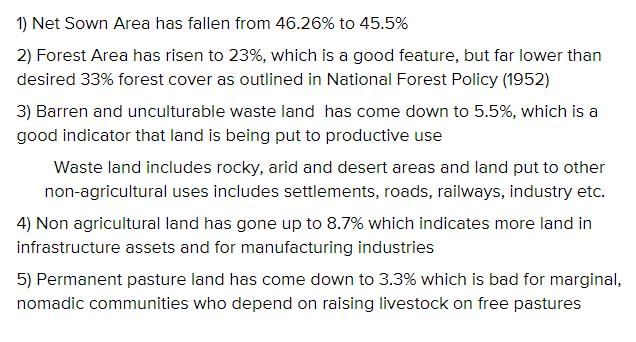Class 10 Exam > Class 10 Questions > Compare the land use pattern as it exist now ...
Start Learning for Free
Compare the land use pattern as it exist now (2002 - 03) with that of the past (1960 - 61) and give reasons for changes?
Most Upvoted Answer
Compare the land use pattern as it exist now (2002 - 03) with that of ...

Community Answer
Compare the land use pattern as it exist now (2002 - 03) with that of ...
Land Use Pattern in 1960-61 vs 2002-03
The land use pattern in India has changed significantly over the past few decades due to various factors such as population growth, urbanization, industrialization, and agricultural practices. The land use pattern in 1960-61 was largely dominated by agriculture, while in 2002-03, there was a significant increase in the urban and industrial land use.
In 1960-61, agriculture was the primary land use in India, accounting for approximately 70% of the total land area. However, in 2002-03, the agricultural land use had decreased to approximately 60% due to several factors such as decreasing farm sizes, increasing population, and urbanization. The rapid growth of population and urbanization led to an increase in the demand for non-agricultural land uses, resulting in the conversion of agricultural land to urban and industrial uses.
In 1960-61, urban land use accounted for only 2.7% of the total land area in India, whereas in 2002-03, it had increased to 7.1%. The increase in urban land use is attributed to the rapid pace of urbanization and industrialization, which led to the growth of cities and towns. The urban land use increased mainly due to the construction of residential colonies, commercial complexes, and industrial estates. The boom in the IT sector and the growth of the services sector also contributed to the increase in urban land use.
In 1960-61, the industrial land use was minimal, accounting for only 0.5% of the total land area. However, in 2002-03, the industrial land use had increased significantly to 2.3% due to the growth of the manufacturing sector. The growth of the manufacturing sector led to the establishment of large and small-scale industries, resulting in an increase in the demand for industrial land use. The development of Special Economic Zones (SEZs) also contributed to the increase in industrial land use.
The changes in the land use pattern in India can be attributed to various factors such as:
- Population growth: India's population has increased significantly over the past few decades, leading to an increase in the demand for land for various purposes.
- Urbanization: The rapid pace of urbanization has led to an increase in the demand for non-agricultural land uses such as residential, commercial, and industrial.
- Industrialization: The growth of the manufacturing sector has led to an increase in the demand for industrial land use.
- Agricultural practices: The changing agricultural practices such as the use of high-yielding varieties, mechanization, and irrigation have led to a decrease in the agricultural land use.
- Government policies: The government's policies such as the establishment of SEZs, liberalization of the economy, and urban planning have also contributed to the changes in land use pattern.
In conclusion, the land use pattern in India has changed significantly over the past few decades due to various factors such as population growth, urbanization, industrialization, agricultural practices, and government policies. The increase in urban and industrial land use has led to
Overview
The land use pattern in India has changed significantly over the past few decades due to various factors such as population growth, urbanization, industrialization, and agricultural practices. The land use pattern in 1960-61 was largely dominated by agriculture, while in 2002-03, there was a significant increase in the urban and industrial land use.
Agricultural Land Use
In 1960-61, agriculture was the primary land use in India, accounting for approximately 70% of the total land area. However, in 2002-03, the agricultural land use had decreased to approximately 60% due to several factors such as decreasing farm sizes, increasing population, and urbanization. The rapid growth of population and urbanization led to an increase in the demand for non-agricultural land uses, resulting in the conversion of agricultural land to urban and industrial uses.
Urban Land Use
In 1960-61, urban land use accounted for only 2.7% of the total land area in India, whereas in 2002-03, it had increased to 7.1%. The increase in urban land use is attributed to the rapid pace of urbanization and industrialization, which led to the growth of cities and towns. The urban land use increased mainly due to the construction of residential colonies, commercial complexes, and industrial estates. The boom in the IT sector and the growth of the services sector also contributed to the increase in urban land use.
Industrial Land Use
In 1960-61, the industrial land use was minimal, accounting for only 0.5% of the total land area. However, in 2002-03, the industrial land use had increased significantly to 2.3% due to the growth of the manufacturing sector. The growth of the manufacturing sector led to the establishment of large and small-scale industries, resulting in an increase in the demand for industrial land use. The development of Special Economic Zones (SEZs) also contributed to the increase in industrial land use.
Reasons for Changes
The changes in the land use pattern in India can be attributed to various factors such as:
- Population growth: India's population has increased significantly over the past few decades, leading to an increase in the demand for land for various purposes.
- Urbanization: The rapid pace of urbanization has led to an increase in the demand for non-agricultural land uses such as residential, commercial, and industrial.
- Industrialization: The growth of the manufacturing sector has led to an increase in the demand for industrial land use.
- Agricultural practices: The changing agricultural practices such as the use of high-yielding varieties, mechanization, and irrigation have led to a decrease in the agricultural land use.
- Government policies: The government's policies such as the establishment of SEZs, liberalization of the economy, and urban planning have also contributed to the changes in land use pattern.
Conclusion
In conclusion, the land use pattern in India has changed significantly over the past few decades due to various factors such as population growth, urbanization, industrialization, agricultural practices, and government policies. The increase in urban and industrial land use has led to

|
Explore Courses for Class 10 exam
|

|
Question Description
Compare the land use pattern as it exist now (2002 - 03) with that of the past (1960 - 61) and give reasons for changes? for Class 10 2025 is part of Class 10 preparation. The Question and answers have been prepared according to the Class 10 exam syllabus. Information about Compare the land use pattern as it exist now (2002 - 03) with that of the past (1960 - 61) and give reasons for changes? covers all topics & solutions for Class 10 2025 Exam. Find important definitions, questions, meanings, examples, exercises and tests below for Compare the land use pattern as it exist now (2002 - 03) with that of the past (1960 - 61) and give reasons for changes?.
Compare the land use pattern as it exist now (2002 - 03) with that of the past (1960 - 61) and give reasons for changes? for Class 10 2025 is part of Class 10 preparation. The Question and answers have been prepared according to the Class 10 exam syllabus. Information about Compare the land use pattern as it exist now (2002 - 03) with that of the past (1960 - 61) and give reasons for changes? covers all topics & solutions for Class 10 2025 Exam. Find important definitions, questions, meanings, examples, exercises and tests below for Compare the land use pattern as it exist now (2002 - 03) with that of the past (1960 - 61) and give reasons for changes?.
Solutions for Compare the land use pattern as it exist now (2002 - 03) with that of the past (1960 - 61) and give reasons for changes? in English & in Hindi are available as part of our courses for Class 10.
Download more important topics, notes, lectures and mock test series for Class 10 Exam by signing up for free.
Here you can find the meaning of Compare the land use pattern as it exist now (2002 - 03) with that of the past (1960 - 61) and give reasons for changes? defined & explained in the simplest way possible. Besides giving the explanation of
Compare the land use pattern as it exist now (2002 - 03) with that of the past (1960 - 61) and give reasons for changes?, a detailed solution for Compare the land use pattern as it exist now (2002 - 03) with that of the past (1960 - 61) and give reasons for changes? has been provided alongside types of Compare the land use pattern as it exist now (2002 - 03) with that of the past (1960 - 61) and give reasons for changes? theory, EduRev gives you an
ample number of questions to practice Compare the land use pattern as it exist now (2002 - 03) with that of the past (1960 - 61) and give reasons for changes? tests, examples and also practice Class 10 tests.

|
Explore Courses for Class 10 exam
|

|
Signup to solve all Doubts
Signup to see your scores go up within 7 days! Learn & Practice with 1000+ FREE Notes, Videos & Tests.


























